Discover Seoul's seven most unforgettable Buddhist temples
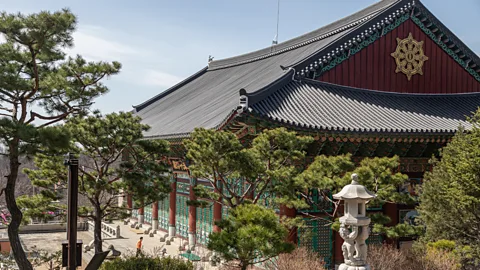 Ben McKechnie
Ben McKechnieFrom Jogyesa to Gilsanga, these are the must-visit temples every traveller should see, according to an acclaimed local Buddhist priest.
"Before we begin", said Jang Jeok, a Buddhist priest whose name means "extreme calmness" in Korean, "you must clear your mind of all traces of city noise. Let us meditate." I'd just hiked an hour uphill through Seoul's Bukhansan National Park to reach Jang at Ilseonsa Temple, where he has lived alone for the last seven years, keeping constant watch over the city below.
For a compact nation, South Korea has an astonishing number of Buddhist temples – approximately 20,000, some of which are more than 1,000 years old. Korean temples stand apart visually from temples in other parts of Asia, as many are timber-frame structures made of Korean red pine that are painted in the country's traditional Dancheong (aquamarine) hue that adornes wooden buildings. Some also feature out-of-this-world chanting. It all combines to produce a soul-soothing recipe for serenity.
Given his intimate and expert familiarity on the topic, I'd come to Jang for his advice about which Buddhist temples travellers should see in Seoul. "While I definitely advise tourists to visit Jogyesa and Bongeunsa, I strongly recommend that they seek out small temples, such as those located by mountains and rivers," he said. "Since they are not commercialised and are in harmony with nature, one is bound to have a more spiritual experience and leave Seoul with better memories."
Here, Jang offers his expert picks of seven Seoul temples you shouldn't miss.
 Ben McKechnie
Ben McKechnie1. Best classic favourite: Jogyesa
According to Jang, no guide to Seoul's best temples would be complete without mentioning Jogyesa. Constructed in 1395, Jogyesa is South Korea's most important temple. It is the chief temple of the Jogye Order that represents the largest segment of the country's Buddhist population – which comprises approximately 1,900 active temples, 13,000 monks and nuns and 7 million followers.
Located in the heart of downtown Seoul, Jogyesa is surrounded by high-rise buildings, creating a wonderful ancient-meets-modern juxtaposition. And while Jang says a temple surrounded by corporate and financial buildings may make for a less spiritual experience, it remains popular with travellers and locals alike. Here, visitors will witness many genuine displays of religious devotion, as people sit outside the doors of Daeungjeon, the main temple hall, studying Buddhist texts before circumambulating the lofty, 500-year-old Sophora japonica tree – also known as "the Scholar tree".
One of Jang's favourite times to visit is in the months leading up to the national holiday of Buddha's birthday (Buchonim oshin nal) in the spring (roughly mid-April to mid-May). During this period, colourful lanterns are strung up like a hanging carpet above the temple grounds and sunlight penetrates the gaps, casting dappled light on everything and everyone below. While lanterns can be found at all temples at this time, they are at their most numerous and impressive at Jogyesa, and temple workers ascend on hydraulic lifts to attach the handwritten prayers of devotees between them.
Website: https://www.jogyesa.kr/eng/index.php
Address: 55 Ujeongguk-ro, Jongno-gu, Seoul
Phone: +82-2-768-8600
 Nattee Chalermtiragool/Alamy
Nattee Chalermtiragool/Alamy2. Best for evening solitude: Bongeunsa
Roughly 10km south-east of Jogyesa is Bongeunsa, one of the country's oldest temples that dates from 794. It runs a variety of cultural programmes for tourists and foreign residents, such as temple stays and Templelife – a 2.5-hour event every Thursday from 14:00 to 16:30 where visitors join a group for a temple tour, tea ceremony and a meditative session spent copying sutras by hand (30,000 KRW/£18.50).
The SpeciaList
Monk Jang Jeok is the head priest of two temples in Seoul: Ilseonsa and Eontongsa. He was previously the planning director of the Jogye Order, Korea's largest Buddhist sect, and he also served as the head of the Buddhist Broadcasting Bureau.
Visit Bongeunsa in the evening as the blue hour fades to night, when the temple empties out to just a few lone souls. On weekdays, if you linger in the courtyard in front of the main hall where a monk may be chanting as incense burns, you'll notice a handful of office workers visiting to pray and bow. Jang also suggests exploring the grounds away from the big hall, moving in the opposite direction to the main road outside to seek quiet and solitude until the only sound that can be heard is the crunch of gravel under foot.
Overhead loom the city's tallest and glitziest high-rise apartment towers, a sign that you're in Gangnam District's Samseong-dong neighbourhood, one of Seoul's most affluent areas. Don't miss the 23m-tall Maitreya statue – the future Buddha who will one day descend to Earth to preach the dharma anew – whose reflection in the polished stone floor is a sight to behold at this time of evening. Nearby, there's a simple on-site eatery serving vegan temple food (such as soft tofu, greens, rice and a light soup).
Website: http://www.bongeunsa.org/
Address: 531 Bongeunsa-ro, Gangnam-gu, Seoul
Phone: +82-2-3218-4800
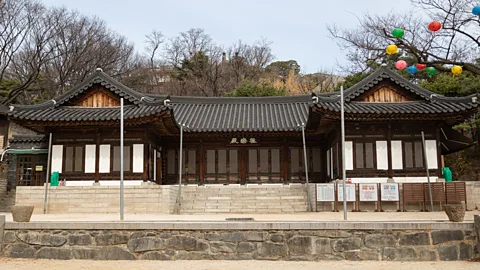 Ben McKechnie
Ben McKechnie3. Best for history: Gilsanga
According to Jang, the modern temple of Gilgangsa may have the most fascinating story of any temple in Seoul. While the building itself is considerably older, it only became a working temple in 1997. It was originally a famous yojeong (a restaurant where powerful male political figures would meet after dark to dine and interact with courtesans) calledDaewongak. Daewongak was one of the three-most popular restaurants of its kind in the 1970s and '80s and was owned by a gisaeng (a woman from an outcast or slave family trained to be a courtesan to provide entertainment and converse with upper-class men) named Kim Yeong-han (1916-1999).
In the mid-1990s, Kim decided to change the course of her life after reading and being powerfully affected by the book Musoyu (Non-Possession) by a monk named the Venerable Beopjeong, and she informed him that she wished to donate the sprawling property – valued in the millions of dollars – to him to turn it into a temple. In return she received the Buddhist name Gilsanghwa and a simple set of prayer beads. Beopjeong fulfilled her wish in 1997 by opening the new temple to the public. Today, Gilsangsa runs cultural programmes with names such as "Find Your True Self in the Busy City" – as, indeed, Kim believed that she had at the end of her life.
According to Jang, visitors can spot various features from its previous incarnation as Daewongak while walking through Gilsangsa's landscaped grounds. For example, some of the small outbuildings and rooms have been repurposed from their days as the domain of courtesans and turned into solitary meditation rooms. Jang says that Gilsangsa is best visited by first going to the Hansung University subway station on Line 4 before taking a local bus up the hill to the temple.
Website: http://www.kilsangsa.info/home/default_in.asp
Address: 68 Seonjam-ro 5-gil, Seongbuk-gu, Seoul
Phone: +82-2-3672-5947
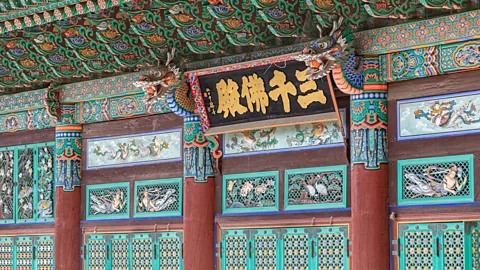 Ben McKechnie
Ben McKechnie4. Best for ancient traditions: Bongwonsa
Jang is particularly fond of Bongwonsa, a temple nestled at the foot of Ansan Mountain, west of the downtown area. Founded in 889, Bongwonsa belongs to the Taego Order, the second-largest order of Korean Buddhism. Unlike the Jogye Order, whose monks must remain celibate, Taego monks are allowed to marry and have children (although notably nuns of both orders must remain celibate). "This leads to a hereditary line of monks, where one becomes a monk if one's father was a monk," Jang said. "This in turn has led to the strong preservation of ancient traditions, Buddhist artefacts and things such as traditional Korean dances."
Among these traditions is an unmissable event in early June each year known as the Yeongsanjae, where world peace and the reunification of North and South Korea are the themes of traditional music and dance performances. The Seoul Lotus Flower Culture Festival is also held here later in the summer. "There's nowhere else in Seoul like Bongwonsa," said Jang.
To get here from Sinchon station, take the 7024 bus for a seven-minute ride into what feels like a historical village of well-preserved traditional houses deep in the countryside. It's a world away from the metal and glass of the skyscrapers of Seoul's Mapo District, where Sinchon station is located and where most visitors arrive.
Website: http://bongwonsa.or.kr/eng/
Address: 75-66, Bongwonsa-gil, Seodaemun-gu, Seoul
Phone: +82-2-392-3007
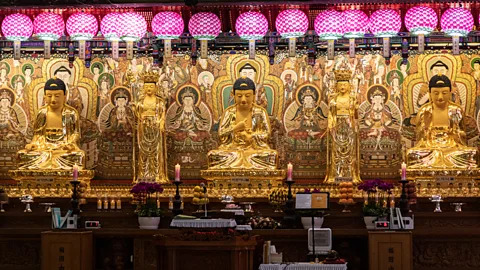 Ben McKechnie
Ben McKechnie5. Best for a natural escape: Hwagyesa
Hwagyesa, built in 1522, is a serene temple complex surrounded by the foothills of Mt Samgak. Encircled by forest, the temple has a strong connection to nature, which ticks one of Jang's boxes for a ensuring a truly spiritual experience. Moreover, temple stays are possible here, bookable through the national temple stay website at the office opposite Jogyesa, or directly by emailing Hwagyesa. "You're just a 15-minute walk from the nearest station [Hwagye station], but you wake up feeling as though you're in the middle of the countryside," said Jang.
Hwagyesa is also a popular temple for foreign monks to come and visit its renowned Buddhist education centre. The Seoul International Zen Center, based at Hwagyesa, offers a three-month meditation course every summer. Also, Hwagyesa offers weekly classes for tourists and foreign residents who wish to learn about Buddhism every Saturday.
As you walk uphill to the temple complex from the entrance gate, you'll hear the sound of running water from a crystal-clear stream beside the lane. You may also run into happy-but-slightly-bleary-eyed visitors who wake up at 04:00 each morning to meditatively perform 108 prostrations – which pales in comparison to the 3,000 performed here by monks and nuns on the last Saturday of every month.
Website: http://www.hwagyesa.org/
Address: 117, Hwagyesa-gil, Suyu 1-dong, Gangbuk-gu, Seoul
Phone: +82-2-902-2663
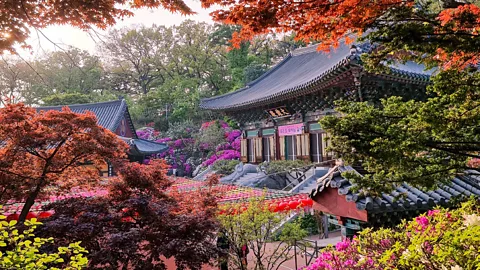 Ana Isabel Ferrer Ramirez
Ana Isabel Ferrer Ramirez6. Best for easy access: Yeonghwasa
Yeonghwasa, located near the city's eastern boundary, was founded in 674 and has one of the longest histories of any temple in Seoul. In Jang's opinion, it is also one of Seoul's most beautiful temples, thanks to its secluded location in a pine forest on the side of Achasan Mountain. He recommends Yeonghwasa for its ease of access, either by car, bus or subway. Additionally, its proximity to Seoul Children's Grand Park (featuring a park, a zoo, theme park rides and a concert hall) makes it an excellent option for families.
Although it's easy to miss it, Jang recommends seeking out the serene statue of the Maitreya. To locate him, first find the tower housing a giant bell – rung precisely 28 times in the morning and 33 times in the evening to save the souls of all sentient beings in the Universe – and follow a 108-step trail up to the right of it. At the top of the hill is a hall housing the 3.5m-tall Maitreya Buddha, an enigmatically smiling statue said to be capable of healing chronic illnesses, among other miracles.
Address: 107 Yeonghwasa-ro, Gueui-dong, Gwangjin-gu, Seoul
Phone: +82-2-444-4321
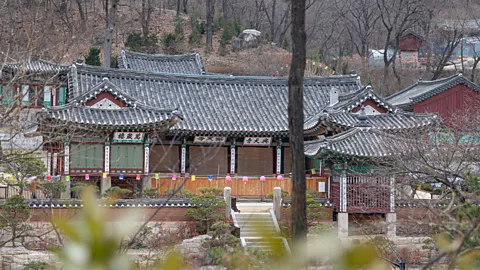 Ben McKechnie
Ben McKechnie7. Best for classic architecture: Heungcheonsa
"Heungcheonsa, founded in 1397, preserves the traditional style of Korean Buddhist architecture better than any other, and it was originally built as a site of prayer and mourning for a queen," said Jang.
Know before you go
• Temple Stay is a great resource to learn more about temple lodging and book one for your trip to Seoul.
• If a monk or nun passes you, consider stopping and bowing slightly to show respect, placing your palms together in front of your chest.This is known as hapjang.
According to Jang, Heungcheonsa represents how temples used to look, with its varied roof tiles and white columns painted with black hanja script (Korean written in Chinese characters). Throughout its history, Heungcheonsa was a favourite temple of the Korean royal family, who frequently paid for its repairs and expansions, even rebuilding it from scratch when it burned to the ground more than once. It was also the first headquarters of the Jogye Order, and one of its rooms hosted a scholar working on developing hangeul – the Korean alphabet – on the order of the revered King Sejong. For Jang, this combination of historical importance and unique visuals makes it stand out. Inquire in the visitor's centre about the handwriting of King Yeongchin, the last crown prince of the Korean Empire, from when he was five years old, which the temple keeps in its collection.
Today, the temple's six main halls and bell tower are dwarfed by modern high-rise apartment blocks that tower over the temple. It's an incongruous setting, but not unphotogenic; for architecture buffs, this in-your-face contrast may well be reason enough to visit. Don't miss the shiny new information centre opposite the temple where visitors can learn more about the history of the temple.
Website: http://www.heungcheonsa.net/
Address: 29 Heungcheonsa-gil, Seongbuk-dong, Seoul
Phone: +82-2-929-6611
BBC Travel's The SpeciaList is a series of guides to popular and emerging destinations around the world, as seen through the eyes of local experts and tastemakers.
---
Join more than three million BBC Travel fans by liking us on Facebook, or follow us on Twitter and Instagram.
If you liked this story, sign up for The Essential List newsletter – a handpicked selection of features, videos and can't-miss news delivered to your inbox every Friday.
